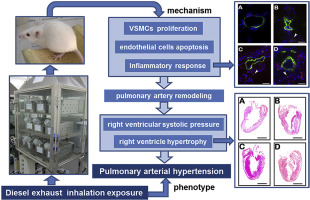Environmental Pollution ( IF 8.9 ) Pub Date : 2017-11-11 , DOI: 10.1016/j.envpol.2017.10.121 Jing Liu , Xiaoqing Ye , Dapeng Ji , Xiaofei Zhou , Cong Qiu , Weiping Liu , Luyang Yu

|
Diesel exhaust (DE) is one of the main sources of urban air pollution. An increasing number of evidence showed the association of air pollution with cardiovascular diseases. Pulmonary arterial hypertension (PAH) is one of the most disastrous vascular diseases, which results in right ventricular failure and death. However, the relationship of DE inhalation exposure with PAH is still unknown. In this study, male adult mice were exposed by inhalation to filtered ambient air (negative control), 10% O2 hypoxia (PAH-phenotype positive control), 350 μg/m3 particulate matter whole DE, or the combination of DE and hypoxic condition. DE inhalation induced PAH-phenotype accompanied with increased right ventricular systolic pressure (RVSP), right ventricle hypertrophy and pulmonary arterial thickening in a mouse model. DE exposure induced the proliferation of vascular smooth muscle cells (VSMCs) and apoptosis of endothelial cells in pulmonary artery. DE inhalation exposure induced an accumulation of CD45+ lymphocytes and CD68+ macrophages surrounding and infiltrating pulmonary arteriole. The levels of pro-inflammatory cytokines tumor necrosis factor (TNF-α), interleukin-6 (IL-6) and IL-13 produced by T helper 17 (Th17) and Th2 cells were markedly elevated in lung tissues of mice after DE inhalation exposure. Our findings suggest DE exposure induces PAH by activating Th17-skewed and Th2-droved responses, stimulating VSMCs proliferation and inducing endothelial cell apoptosis by the production of multifunctional pro-inflammatory cytokines, especially IL-6 and TNF-α. Considering the adverse impact of air pollution on health care, it is imperative to understand air pollution-induced susceptibility of progressive cardiopulmonary disease, such as PAH, and also elucidate critical mechanistic pathways which mediate pulmonary artery vascular remodeling and may serve as targets for preventive measures.
中文翻译:

柴油机尾气吸入引起小鼠肺动脉高压
柴油机废气(DE)是城市空气污染的主要来源之一。越来越多的证据表明空气污染与心血管疾病有关。肺动脉高压(PAH)是最灾难性的血管疾病之一,可导致右心衰竭和死亡。但是,DE吸入暴露与PAH的关系仍然未知。在这项研究中,成年雄性小鼠通过吸入暴露于过滤空气中(阴性对照),10%O 2缺氧(PAH表型阳性对照),350μg/ m 3。颗粒物整个DE,或DE与低氧状态的结合。在小鼠模型中,DE吸入诱导的PAH表型伴有右心室收缩压(RVSP)升高,右心室肥大和肺动脉增厚。DE暴露可引起肺动脉血管平滑肌细胞(VSMC)增殖和内皮细胞凋亡。DE吸入暴露引起CD45 + 淋巴细胞和CD68 +的积累 巨噬细胞围绕并浸润肺小动脉。吸入DE后,T辅助细胞17(Th17)和Th2细胞产生的促炎细胞因子肿瘤坏死因子(TNF-α),白介素-6(IL-6)和IL-13水平明显升高。接触。我们的发现表明,DE暴露通过激活Th17偏斜和Th2驱动的反应,刺激VSMC增殖并通过产生多功能促炎性细胞因子(尤其是IL-6和TNF-α)来诱导PAH诱导PAH。考虑到空气污染对医疗保健的不利影响,必须了解空气污染引起的进行性心肺疾病(如PAH)的易感性,


























 京公网安备 11010802027423号
京公网安备 11010802027423号